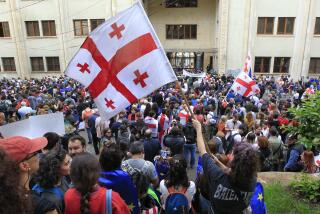Georgian Region Gets Peacekeepers : Conflict: Mission in the former Soviet Union is first of its kind. Troops will include combatants from both sides.
- Share via
MOSCOW — A first-of-its-kind, multinational peacekeeping force was deployed Tuesday in South Ossetia, a remote mountainous region that is one of several active battle zones in the former Soviet Union.
But officials from the area, which is in the newly independent southern republic of Georgia on its border with Russia, admitted that the soldiers on the peacekeeping mission--some of them drawn from the combatants in the conflict--may end up killing each other.
The goal of the troops is to create a 4-mile-wide neutral corridor between Georgians and South Ossetians, who want to secede from Georgia and join neighboring North Ossetia within Russia. The two sides have been locked in territorial warfare for almost two years.
Battalions of 200 Russian soldiers, 200 members of the Georgian national guard and 200 Ossetians are expected to report to the region Tuesday and today. A second wave of 300 men from each participating army will follow. They wear helmets with light blue stripes and matching armbands like U.N. peacekeepers and will be equipped with small arms, helicopters and armored vehicles.
“The three battalions (of 500 men) will live separately but serve together,” said Valiko G. Gogolashvili, spokesman for Georgia’s Interior Ministry. “Forty-two observation points will be set, and an equal number of Georgian, Russian and Ossetian troops will be posted at each one.”
On the eve of their deployment, four civilians were killed and two wounded near the South Ossetian capital of Tskhinval, Russia’s Itar-Tass news agency reported.
Both Georgians and Ossetians admitted that the troops will find it difficult to stop the armed bands that terrorize the region and to remain impartial, especially considering the deep hatred many Georgians and Ossetians feel for each other after hundreds of ruthless killings of civilians on each side.
“Of course we all here feel great concern about the compatibility within the force itself,” Gogolashvili said in a telephone interview from Tbilisi, the capital of the former Soviet republic of Georgia. “There is a risk, which cannot be brushed aside easily, that conflicts will arise between Georgians and Ossetians in the force.”
Ossetians were equally cautious about the peacekeeping force, which was created on the basis of an agreement between Russian President Boris N. Yeltsin and Georgian leader Eduard A. Shevardnadze, the former Soviet foreign minister. “The force has strict orders to eliminate any position on either side that opens fire,” said Kazbek N. Sakhilov, chairman of North Ossetia’s parliamentary commission on nationalities.
“But here comes the big question: Will, for instance, Ossetian (peacekeeping) soldiers obey an order to eliminate a point of fire on the Ossetian side? My colleagues and I have been constantly asking ourselves this uneasy and troubling question and coming up with no easy answer, to be quite frank.”
But Col. Artovazd Vartayan, an officer on the force, told the military newspaper Krasnaya Zvezda: “The battalions are going there not to fight somebody but to bring peace.”
Posting the buffer force in the area marked the first time since the Soviet Union collapsed that troops representing what are now independent governments have been sent on a joint peace mission.
A similar contingent may be sent in the next couple of weeks to help end bloodshed between Moldovans and separatist Russians in the southern republic of Moldova.
Although there was uncertainty about whether the troops would achieve their goal in Ossetia, the decision to send them was hailed as a positive change.
In the several months since Yeltsin took over command of what used to be the Soviet army, the trend has been to pull troops out of tense regions and let the warring sides fight it out.
While former Soviet President Mikhail S. Gorbachev was in command, Soviet soldiers were posted in hot spots of ethnic violence but were accused of heightening the conflicts to suit their own, or the Kremlin’s, agenda.
“At last, the efforts of politicians toward resolving the conflict in South Ossetia have taken the shape of concrete action,” Akhsarbek Galazov, chairman of the council of ministers of North Ossetia, told Krasnaya Zvezda. “But a full guarantee that plans will be followed through can be given only if the people of South and North Ossetia and Georgia actively involve themselves in the peace process.”
Sergei V. Yastrzhembsky, the spokesman for the Russian Foreign Ministry, said the joint peacekeeping mission could set a positive precedent.
“It is possible that South Ossetia will become the first region in the territory of the former Soviet Union where an armed conflict is ended with the help of political measures.”
More to Read
Sign up for Essential California
The most important California stories and recommendations in your inbox every morning.
You may occasionally receive promotional content from the Los Angeles Times.













